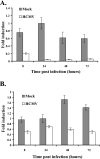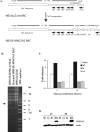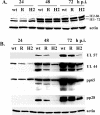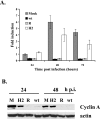Repression of HMGA2 gene expression by human cytomegalovirus involves the IE2 86-kilodalton protein and is necessary for efficient viral replication and inhibition of cyclin A transcription
- PMID: 17005673
- PMCID: PMC1617307
- DOI: 10.1128/JVI.01300-06
Repression of HMGA2 gene expression by human cytomegalovirus involves the IE2 86-kilodalton protein and is necessary for efficient viral replication and inhibition of cyclin A transcription
Abstract
Human cytomegalovirus (HCMV) infection results in dysregulation of several cell cycle genes, including inhibition of cyclin A transcription. In this work, we examine the effect of the HCMV infection on expression of the high-mobility group A2 (HMGA2) gene, which encodes an architectural transcription factor that is involved in cyclin A promoter activation. We find that expression of HMGA2 RNA is repressed in infected cells. To determine whether repression of HMGA2 is directly related to the inhibition of cyclin A expression and impacts on the progression of the infection, we constructed an HCMV recombinant that expressed HMGA2. In cells infected with the recombinant virus, cyclin A mRNA and protein are induced, and there is a significant delay in viral early gene expression and DNA replication. To determine the mechanism of HMGA2 repression, we used recombinant viruses that expressed either no IE1 72-kDa protein (CR208) or greatly reduced levels of IE2 86-kDa (IE2 86) protein (IE2 86DeltaSX-EGFP). At a high multiplicity of infection, the IE1 deletion mutant is comparable to the wild type with respect to inhibition of HMGA2. In contrast, the IE2 86DeltaSX-EGFP mutant does not significantly repress HMGA2 expression, suggesting that IE2 86 is involved in the regulation of this gene. Cyclin A expression is also induced in cells infected with this mutant virus. Since HMGA2 is important for cell proliferation and differentiation, particularly during embryogenesis, it is possible that the repression of HMGA2 expression during fetal development could contribute to the specific birth defects in HCMV-infected neonates.
Figures







Similar articles
-
Disruption of PML-associated nuclear bodies by IE1 correlates with efficient early stages of viral gene expression and DNA replication in human cytomegalovirus infection.Virology. 2000 Aug 15;274(1):39-55. doi: 10.1006/viro.2000.0448. Virology. 2000. PMID: 10936087
-
The IE2 60-kilodalton and 40-kilodalton proteins are dispensable for human cytomegalovirus replication but are required for efficient delayed early and late gene expression and production of infectious virus.J Virol. 2007 Mar;81(6):2573-83. doi: 10.1128/JVI.02454-06. Epub 2007 Jan 3. J Virol. 2007. PMID: 17202222 Free PMC article.
-
Exon 3 of the human cytomegalovirus major immediate-early region is required for efficient viral gene expression and for cellular cyclin modulation.J Virol. 2005 Jun;79(12):7438-52. doi: 10.1128/JVI.79.12.7438-7452.2005. J Virol. 2005. PMID: 15919900 Free PMC article.
-
Bright and Early: Inhibiting Human Cytomegalovirus by Targeting Major Immediate-Early Gene Expression or Protein Function.Viruses. 2020 Jan 16;12(1):110. doi: 10.3390/v12010110. Viruses. 2020. PMID: 31963209 Free PMC article. Review.
-
Human cytomegalovirus riding the cell cycle.Med Microbiol Immunol. 2015 Jun;204(3):409-19. doi: 10.1007/s00430-015-0396-z. Epub 2015 Mar 17. Med Microbiol Immunol. 2015. PMID: 25776080 Review.
Cited by
-
The presence of p53 influences the expression of multiple human cytomegalovirus genes at early times postinfection.J Virol. 2009 May;83(9):4316-25. doi: 10.1128/JVI.02075-08. Epub 2009 Feb 18. J Virol. 2009. PMID: 19224996 Free PMC article.
-
Development of cell lines that provide tightly controlled temporal translation of the human cytomegalovirus IE2 proteins for complementation and functional analyses of growth-impaired and nonviable IE2 mutant viruses.J Virol. 2008 Jul;82(14):7059-77. doi: 10.1128/JVI.00675-08. Epub 2008 May 7. J Virol. 2008. PMID: 18463148 Free PMC article.
-
Alternative splicing of the human cytomegalovirus major immediate-early genes affects infectious-virus replication and control of cellular cyclin-dependent kinase.J Virol. 2011 Jan;85(2):804-17. doi: 10.1128/JVI.01173-10. Epub 2010 Nov 10. J Virol. 2011. PMID: 21068259 Free PMC article.
-
Recruitment of cdk9 to the immediate-early viral transcriptosomes during human cytomegalovirus infection requires efficient binding to cyclin T1, a threshold level of IE2 86, and active transcription.J Virol. 2009 Jun;83(11):5904-17. doi: 10.1128/JVI.02651-08. Epub 2009 Mar 18. J Virol. 2009. PMID: 19297489 Free PMC article.
-
Inhibition of human cytomegalovirus immediate-early gene expression by cyclin A2-dependent kinase activity.J Virol. 2012 Sep;86(17):9369-83. doi: 10.1128/JVI.07181-11. Epub 2012 Jun 20. J Virol. 2012. PMID: 22718829 Free PMC article.
References
-
- Anand, A., and K. Chada. 2000. In vivo modulation of Hmgic reduces obesity. Nat. Genet. 24:377-380. - PubMed
-
- Arlotta, P., A. K. Tai, G. Manfioletti, C. Clifford, G. Jay, and S. J. Ono. 2000. Transgenic mice expressing a truncated form of the high mobility group I-C protein develop adiposity and an abnormally high prevalence of lipomas. J. Biol. Chem. 275:14394-14400. - PubMed
-
- Baldassarre, G., M. Fedele, S. Battista, A. Vecchione, A. J. Klein-Szanto, M. Santoro, T. A. Waldmann, N. Azimi, C. M. Croce, and A. Fusco. 2001. Onset of natural killer cell lymphomas in transgenic mice carrying a truncated HMGI-C gene by the chronic stimulation of the IL-2 and IL-15 pathway. Proc. Natl. Acad. Sci. USA 98:7970-7975. - PMC - PubMed
Publication types
MeSH terms
Substances
Grants and funding
LinkOut - more resources
Full Text Sources
Molecular Biology Databases

